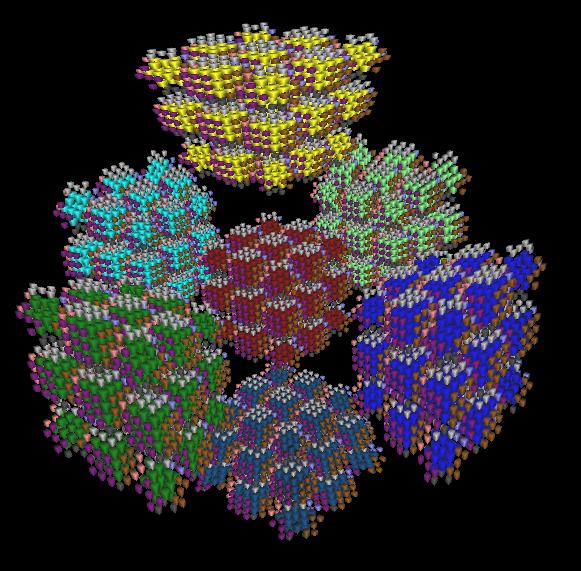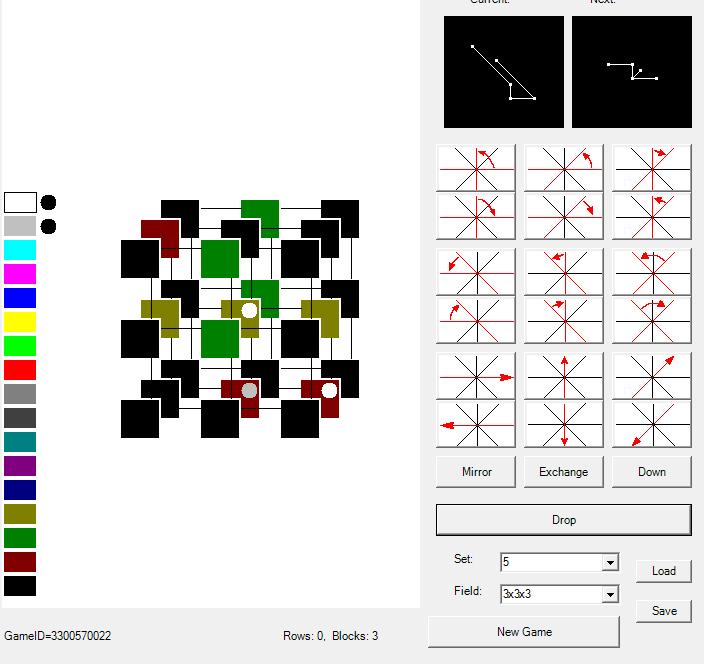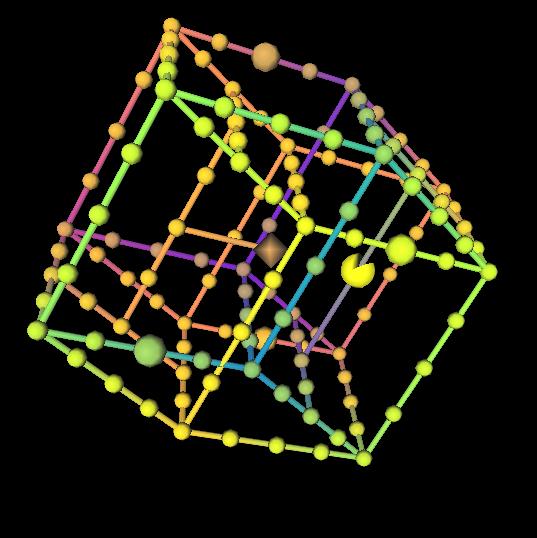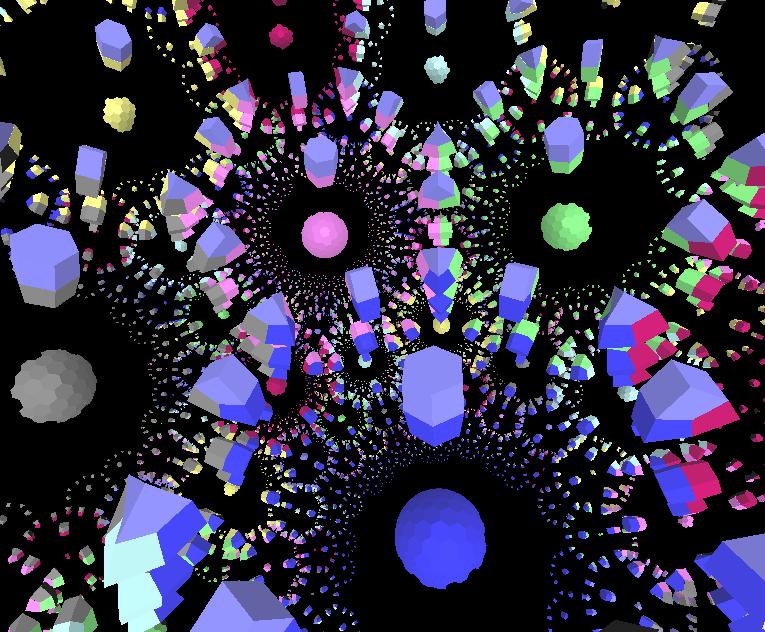Ways of visualization in multi-dimensional games
... A couple of years ago there was already a topic on a similar topic, I want to share my thoughts ...
One of the problems arising when writing a game, the space of action of which contains more than three spatial dimensions, is visualization of the action scene that is sufficiently understandable to the user and suitable for controlling both the character (or object) of the game and the virtual camera creating the image.
Most of the multidimensional games that I came across lately were puzzles - analogs of the Rubik's cube. But for different dimensions of the puzzle, the authors had to use different ways of visualization.
')
In these games, the working object is a convex four-dimensional polyhedron, most often with a high degree of symmetry (for example, an equal face). Initially, each face of it is painted in its own color, but when the faces are turned, the colors are mixed. The goal is to restore the original color order.
All vertices of the polyhedron lie on the four-dimensional sphere. For visualization, a stereographic projection of this grid (set of vertices) onto three-dimensional space is taken, and three-dimensional polyhedra are constructed in it - projections of the faces of the original cube. The faces are divided into smaller polyhedra (“stickers” are analogs of small squares in a regular cube), which are slightly smaller (so that you can see the internal stickers, if any). The resulting model is depicted in a 3D viewer with a camera, constantly aimed at the center of the model. In the particular case of the tesseract, 7 faces can be seen, this is enough for the game. You can control the focal length of the camera (angle of view) and the distance from the camera to the center.

The visualization goes about the same, but the stereographic projection goes to 4-dimensional space. Further, it is re-designed on a three-dimensional. Four-dimensional stickers are depicted in the form of edge patterns, the colors of the edges correspond to the colors of the original stickers.

Four “basic” measurements and three “additional” measurements are selected. Seven faces in the main dimensions are considered, each of them is a six-dimensional cube. This cube is depicted in a fractal way: it is divided according to basic dimensions into N ^ 3 cubes, each of which, in turn, consists of N ^ 3 stickers in additional dimensions.
The main faces are the same as the faces of a 4-dimensional cube in stereographic projection.
To show at least some of the faces in the extra dimensions, their stickers are considered. adjacent to the "main" faces, and are placed on the surface of small cubes of each face (thus, they are not N ^ 3, but (N + 2) ^ 3).
As it turns out, to assemble such a seven-dimensional cube is quite realistic.

It does not even use a three-dimensional viewer - the projection goes immediately to 2D. We look at the glass from above, we see a rectangular parallelepiped, each cell of which is filled to its height. The cells are depicted in a standard way (a rectangle consisting of diagonal chains of cells), the height is color coded. The falling figure is depicted, firstly, by its frame model, secondly, by a shadow (part of the cells is shaded), and thirdly, on the vertical projection of the glass (where the order of colors and the position of the figure are visible)

Used frame model of the maze (segments on which you can walk). The model is projected into a three-dimensional space (additional coorinates are shown in color — the yellow-violet axis for U and the red-blue for V). Labyrinth is shown in the 3D-viewer. You can rotate the camera (it also serves to control the peckman) in 3D (right / left and up / down), and in the color space (in yellow, purple, blue, etc.). These turns look like model distortions — some of the vertices are approaching, some are removed, and some parts of the maze change color.

For visualization, the usual 3D viewer is used, the camera is located inside the space, the rays propagate along straight lines (geodetic spaces of Lobachevsky). The camera sensor is almost flat.

There is another way of visualization (used in the BlockBuilding-game ) - honest vision with a three-dimensional retina: first it is calculated what the camera sees (this is painted three-dimensional space), and then it is projected on 2D. Probably, this makes sense only when rendering in the form of segments or translucent 2D faces.
One of the problems arising when writing a game, the space of action of which contains more than three spatial dimensions, is visualization of the action scene that is sufficiently understandable to the user and suitable for controlling both the character (or object) of the game and the virtual camera creating the image.
Most of the multidimensional games that I came across lately were puzzles - analogs of the Rubik's cube. But for different dimensions of the puzzle, the authors had to use different ways of visualization.
')
Four-dimensional analogs of the Rubik's cube
In these games, the working object is a convex four-dimensional polyhedron, most often with a high degree of symmetry (for example, an equal face). Initially, each face of it is painted in its own color, but when the faces are turned, the colors are mixed. The goal is to restore the original color order.
All vertices of the polyhedron lie on the four-dimensional sphere. For visualization, a stereographic projection of this grid (set of vertices) onto three-dimensional space is taken, and three-dimensional polyhedra are constructed in it - projections of the faces of the original cube. The faces are divided into smaller polyhedra (“stickers” are analogs of small squares in a regular cube), which are slightly smaller (so that you can see the internal stickers, if any). The resulting model is depicted in a 3D viewer with a camera, constantly aimed at the center of the model. In the particular case of the tesseract, 7 faces can be seen, this is enough for the game. You can control the focal length of the camera (angle of view) and the distance from the camera to the center.

Five-dimensional Rubik's Cube
The visualization goes about the same, but the stereographic projection goes to 4-dimensional space. Further, it is re-designed on a three-dimensional. Four-dimensional stickers are depicted in the form of edge patterns, the colors of the edges correspond to the colors of the original stickers.

Seven-dimensional cube
Four “basic” measurements and three “additional” measurements are selected. Seven faces in the main dimensions are considered, each of them is a six-dimensional cube. This cube is depicted in a fractal way: it is divided according to basic dimensions into N ^ 3 cubes, each of which, in turn, consists of N ^ 3 stickers in additional dimensions.
The main faces are the same as the faces of a 4-dimensional cube in stereographic projection.
To show at least some of the faces in the extra dimensions, their stickers are considered. adjacent to the "main" faces, and are placed on the surface of small cubes of each face (thus, they are not N ^ 3, but (N + 2) ^ 3).
As it turns out, to assemble such a seven-dimensional cube is quite realistic.

Four-dimensional tetris
It does not even use a three-dimensional viewer - the projection goes immediately to 2D. We look at the glass from above, we see a rectangular parallelepiped, each cell of which is filled to its height. The cells are depicted in a standard way (a rectangle consisting of diagonal chains of cells), the height is color coded. The falling figure is depicted, firstly, by its frame model, secondly, by a shadow (part of the cells is shaded), and thirdly, on the vertical projection of the glass (where the order of colors and the position of the figure are visible)

> Five-Dimension Packman
Used frame model of the maze (segments on which you can walk). The model is projected into a three-dimensional space (additional coorinates are shown in color — the yellow-violet axis for U and the red-blue for V). Labyrinth is shown in the 3D-viewer. You can rotate the camera (it also serves to control the peckman) in 3D (right / left and up / down), and in the color space (in yellow, purple, blue, etc.). These turns look like model distortions — some of the vertices are approaching, some are removed, and some parts of the maze change color.

Puzzle in Lobachevsky space
For visualization, the usual 3D viewer is used, the camera is located inside the space, the rays propagate along straight lines (geodetic spaces of Lobachevsky). The camera sensor is almost flat.

"Three-dimensional retina"
There is another way of visualization (used in the BlockBuilding-game ) - honest vision with a three-dimensional retina: first it is calculated what the camera sees (this is painted three-dimensional space), and then it is projected on 2D. Probably, this makes sense only when rendering in the form of segments or translucent 2D faces.
Source: https://habr.com/ru/post/111507/
All Articles